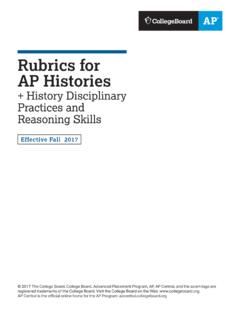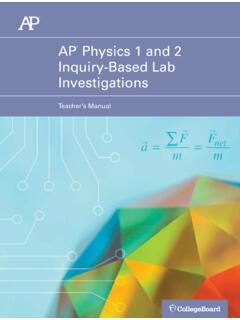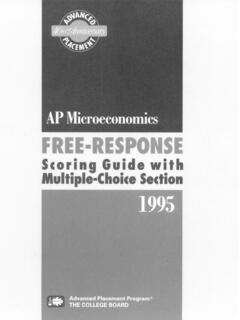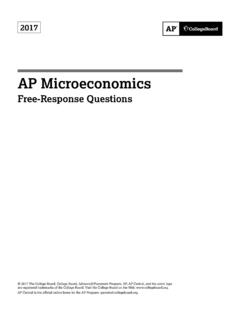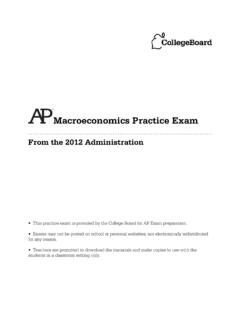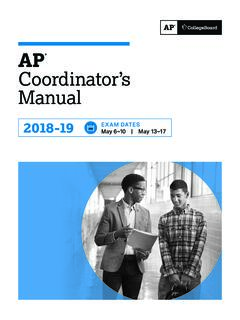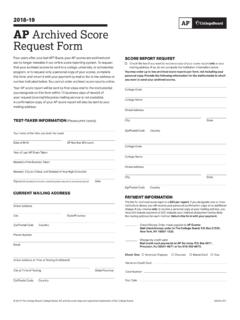Transcription of Sample Student Responses - Packet 3 - AP Central
1 2020. AP English Language . and Composition Sample Student Responses - Packet 3. Rhetorical Analysis Question - Obama 2020 College Board. College Board, Advanced Placement, AP, AP Central , and the acorn logo are registered trademarks of College Board. Visit College Board on the web: AP Central is the official online home for the AP Program: AP English Language and Composition Rhetorical Analysis Free-Response Question (2020). Sample Student Responses Sample A. [1] It is not an uncommon thing for eulogies to be delivered at funerals. The point in mind is to immortalize in language the person who has passed for their most admirable qualities, and remember them for the things they achieved in life. In some cases it is done more effectively than in others, as can be seen in Obama's eulogy in 2009, which he delivered to remember the loss of Ted Kennedy.
2 With appeals to both pathos and logos, the application of anecdote, and a respectful, admiring tone, Obama's intended purpose in his eulogy for Kennedy is clear; he paints the late Ted Kennedy in a respectable, memorable light, which those attending the funeral would forever remember the late Senator by. [2] Perhaps the most frequently applied and effective device employed by Obama in his speech is the use of personal anecdotes from the late Senator's life. In one striking tale about Kennedy, Obama says that Ted Kennedy was the baby of the family who became its patriarch . he was the sunny, joyful child, who bore the brunt of his brothers' teasing, but quickly learned to brush it off. This familial dynamic described in the quote is one that most people can relate to on some level, as most families have a member who is an underdog in the social pecking order.
3 Obama describes Kennedy's rise to respect within his family and in life as a whole, painting him as a human being, not an untouchable political figure. [3] That ability to relate to Kennedy on such a personal level enhanced the effects of Obama's appeal to pathos, which is used frequently throughout the entirety of the speech. [Kennedy] lost two siblings by the age of sixteen. He saw two more taken violently from the country that loved and experienced personal failings and setbacks in the most public way possible. It is a string of events that would have broken a lesser man. If there is one thing that allows an audience to empathize with a person in a situation such as this, it is the mention of tragedy. It is the one thing that all human beings can understand to some degree, and in this situation serves to show just how human Kennedy was.
4 Obama later mentions that this suffering only increased Kennedy's drive to do good, which is an admirable trait. [4] Obama also appeals to ethos, or credibility, by mentioning Kennedy's long list of successes, which juxtaposed the personal losses and failures experienced by the same man. Obama mentions Kennedy's role in the creation of law, stating that Kennedy's name graces nearly one thousand laws, and who penned more than three hundred himself. A man with the power to shape the law itself is a respectable position. On top of this, Obama at the time was also a Senator, which gives his opinion a certain level of credibility. [5] The tone throughout the entire speech is no doubt one of admiration, which can be seen through Obama's word choice. Of the things Obama described him as, some described the tone particularly well; the Happy Warrior' , a restless dreamer , and a voice to those left unheard are a select few phrases used to describe Kennedy which paint him a truly great man, 1.
5 AP English Language and Composition Rhetorical Analysis Free-Response Question (2020). Sample Student Responses who achieved many things in his life. Based on Obama's description of him throughout the speech, he is a truly admirable man. [6] It was Obama's appeal to ethos and pathos, use of anecdote and admiring tone which immortalized the memory of Kennedy as a man worthy of respect. 2. AP English Language and Composition Rhetorical Analysis Free-Response Question (2020). Sample Student Responses Sample B. [1] In August of 2009, President Barack Obama gave the eulogy of Senator Ted Kennedy to those attending the funeral. In the Eulogy, Obama pays tribute to both the hardships and accomplishments Kennedy faced and made in his lifetime. While bringing emotion and pride to his audience , Obama uses the rhetorical modes of causal analysis, description, and exemplification to best emphasize Kennedy's life.
6 [2] Throughout the eulogy, Barack Obama uses causal analysis to explain how the hardships in Kennedy's life built him into the man he The first place this is seen is when Obama reminisces of a story from Ted's childhood. Obama uses the device of anecdote when he tells the audience of how when Ted was thrown off of a boat at age six, and instead of getting upset, he climbed back on the boat and learned how to sail. His brothers constantly teased him in many instances such as this. Because of it, Kennedy was able to toughen himself up to those around him. This story of Kennedy's childhood not only provides the audience with a joyful story to brighten the usually melancholy mood at most funerals, but also points out the determined nature in Ted's character. Obama also uses cause- and- effect to build on Kennedy's character when he mentions the many tragedies Ted went through.
7 Obama tells the audience how Kennedy faced the loss of multiple siblings starting when he was very young. But Obama explains that these losses did not hinder Kennedy's greatness, and instead helped him become a more aware and selfless person. This cause- and- effect relationship between tragedy and Kennedy's character appeals to the audience's emotions, by leading them to recognize the sadness Ted felt, as well as inducing pride towards Kennedy's ability to push through it all. Obama's use of causal analysis develops Ted's character and evokes many emotions within his audience that lead them to memorialize Ted for who he was. [3] Within the eulogy, Obama uses description to continue building on the strength and resilience Kennedy had. Towards the beginning of the eulogy, Obama describes Kennedy as a child, saying, He was the sunny, joyful child, who bore the brunt of his brothers' teasing but learned quickly how to brush it off.
8 This description shows the audience how Kennedy's persistent personality began at a young age. Obama also uses description when talking about Kennedy as an adult. He describes Kennedy's voice in the Senate as a force of nature which effectively conveys a prideful mood towards the audience. The audience hears this description and is led to remember how they heard Kennedy within the Senate chamber and feels the power behind his voice. Obama uses both the description from Kennedy's childhood and his adulthood to provide separate times where Kennedy established his confidence in order to cause the audience at the funeral to praise and memorialize Ted and his character. [4] The final rhetorical mode used by Barack Obama within the eulogy is exemplification. One of the main ideas within the eulogy is how Kennedy was able to push past obstacles that the 3.
9 AP English Language and Composition Rhetorical Analysis Free-Response Question (2020). Sample Student Responses average man would not be able to face. Obama provides many examples of these obstacles, from witnessing death within his family to surviving horrific events like a plane crash. These examples provoke pride within the audience. Those attending the funeral are able to recognize that the things that Kennedy went through were more traumatic than they themselves would likely be able to handle. This means that Kennedy was a stronger man than most and should be recognized as extraordinary for it. Obama also uses exemplification by listing the many laws Kennedy was able to pass that helped a massive amount of people. Despite the trauma Kennedy faced, he was able to help many others from feeling the same. This appeals to the audience's sense of pride once again, in that they are grateful for all that Kennedy did within his life to help as many people as he could.
10 By providing examples of both traumatic obstacles and the accomplishments Kennedy made despite them, Barack Obama is able to memorialize the late Senator and cause the audience to feel pride and gratitude towards his character. [5] Barack Obama uses exemplification, description, and causal analysis to invoke pride within his audience and memorialize Ted Kennedy. The use of exemplification recognized exactly what Kennedy faced as well as the many ways he helped others within his life. The descriptions provided gave detailed accounts of Kennedy at two distant points of his life that showed who he was. The use of causal analysis explains to the audience how Kennedy became who he was. All of the rhetorical modes were able to recognize how great Kennedy was as both an individual and a Senator. 4. AP English Language and Composition Rhetorical Analysis Free-Response Question (2020).

